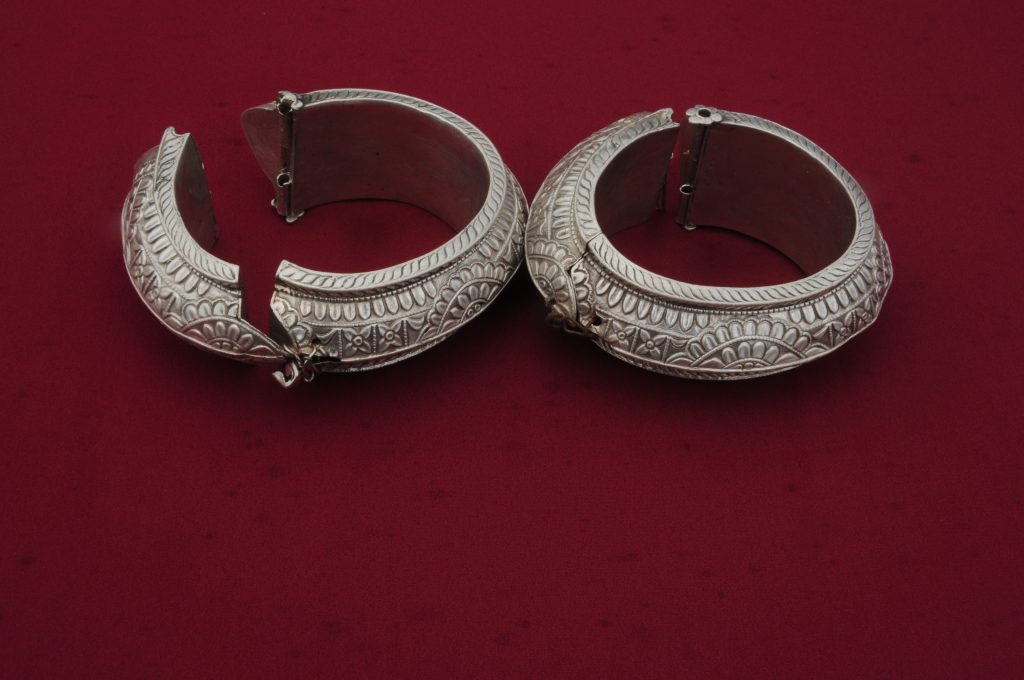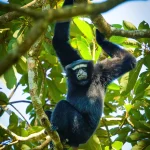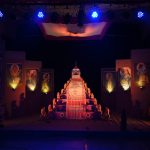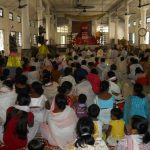Saint Srimanta Sankaradeva, who lived from 1449 to 1568 AD founded the Vaishnavite order Eka Sarana Nāma Dharma. He preached devotion to the supreme entity, lord Krishna. All devotees of that supreme entity are considered as equal entities in his order. It was a classless and casteless social order that the saint preached. All devotees received equal treatment in his order, irrespective of whether he was a rich man or a beggar. He refused to accept Koch king Naranarayan as disciple since the king would not sit at equal level with other devotees. The saint asked his disciples to treat everyone, even the donor and the thief, with equal vision. [Kirtana-ghoshā, Srimanta Sankaradeva, verse 1822] It was thus an egalitarian order.
Srimanta Sankaradeva built a new institutional structure at Tembuwani in 1509 AD, which came to be known as Thān over time. Some people started calling it Sattra in later days. Earlier also a Thān had been set up there in a skeleton form way back in 1468 AD. In 1509 AD, he made it full-fledged with four rows of houses, called four Hāti, for the devotees on the four sides of the prayer-house called Kirtanghar. This prayer-house was the nerve-centre of the entire Thān. It is the centre of entire religious activities and is still going strong. The Kirtanghar is popularly known as Nāmghar these days.
Srimanta Sankaradeva was not only a religious preceptor, but also a social reformer. He sanskritized the ethnic groups of the volatile North East India, which saw frequent wars among these groups in those days. But he did not do away with the cultural heritages of these groups and rather incorporated them in his order. So, he is considered as the father of the modern Assamese community, as he integrated the heterogenous people of this land. He also assimilated the people of Assam with the national main-stream, though the concept of Indian nationhood was yet to develop. He was a great messiah, who rescued the people of Brahmaputra valley from the regressive medieval practices like human sacrifice. He brought the tribal people from the fringe of the society to a common position with others in the erstwhile hierarchical society. Even today the ethnic groups of Assam boast of the fusion process of Ek Sarana Nāma Dharma that Sanskritized them without their giving up ethnic heritages.
Srimanta Sankaradeva was a progressive religious leader who brought about massive changes in the then society. He fought the prevailing social system in Brahmaputra valley at a time when the honour of women was at stake in the hands of some Tāntric priests, when education was limited to the higher castes only, when priests belonging to high castes appropriated resources from common ignorant people in the name of rituals. Srimanta Sankaradeva created a new social order where the need of the priests was done away with and no middle man was any more necessary in conducting the religious activities. He introduced the simplicity of the tribal people in the society, which had been suffering from caste hiatus till that time.
After the advent of Srimanta Sankaradeva, Assam has therefore been comparatively free of the negative aspects of the Chaturbarna system, thanks to the egalitarian ideology preached by him. The impact of the classless social system advocated by his Vaishnavite order made the Assamese society egalitarian. All devotees, nay all creatures are considered as equal in this order. The devotees are asked to see the almighty even in dogs, foxes, donkeys. [Kirtana-ghoshā, Srimanta Sankaradeva, verse 1824] The predominant tribal demographic structure enabled the saint to prevent the discriminatory Chaturbarna system of Hinduism take firm root in Assam as the tribal societies were largely egalitarian. Srimanta Sankaradeva incorporated many such ingredients from the ethnic groups in his own order. Vaishnavism preached by him is thus clearly one of the factors of the liberal society of Assam.
Srimanta Sankaradeva was a pioneer in the entire world in using cultural tools like play to preach his ideology, long before Bertolt Brekht. He used the tools of song, dance and drama to preach the ideology of Eka Sarana Nāma Dharma. It started with his epoch-making play Chihna Yātrā enacted in 1468 AD, which was the first ever play in all modern Indian languages. This play incorporated Srimanta Sankaradeva’s own style of song, dance and instrument; these launched the classical school of Sankari music, the classical Satriyā dance and the new innovation of the saint, a drum called Khol.
The creation of these cultural elements resulted in the newly introduced Sankari culture, which also came to be known as Satriyā culture in an extended form. It came to be accepted as the main-stream culture of the state as the saint incorporated elements from different ethnic groups in this culture. In fact, it became the unifying bond of the numerous ethnic groups living in the Brahmaputra valley. The main ethnic groups of the valley are Karbi, Ahom, Kachari, Chutiya, Koch, Mising, Barahi, Moran, Matak, Deuri, Rabha, Tiwa, Kalita, Kayastha, Bodo, Hajang, Garo, Dimasa, Brahmin, Kaivarta, Daivajnya, Kumar, Bonia, Mech, etc. Majority of these groups happen to be tribal. Srimanta Sankaradeva brought about a cultural unity among these ethnic groups for the first time. The modern Assamese community came into being mostly at his initiative. None of the kings and emperors, who ruled in Brahmaputra valley before and after the saint’s lifetime could achieve that. The reason is that the concept of nation-state is not tenable in Assam, which is full of numerous ethnic groups. So, no single king could ever build a nation within the confine of his ethnic domain.
There is a common misconception among a section of people that the founder of Ahom dynasty, Chukapha (1228-1268 AD) was the father of Assamese nation. But the fact is that Chukapha created only a kingdom, not a nation. Moreover, his kingdom covered only a fraction of the area lived in by the composite Assamese community of later years. He would have been a nation builder, had the Assamese nation been like the unitary European nations. But Assamese nation is a multi-ethnic conglomerate. The concept of nation state as in Europe does not apply here. Numerous nation states existed in the Brahmaputra valley in medieval period. There were separate kingdoms of the ethnic groups like the Ahoms, the Kochs, the Chutiyas, the Kacharis, the Bhuyans and so on. Each of these was a nation state. Chukapha was the founder of the nation state lived in by the Ahoms and two other tribes, the Barahis and the Morans, who had submitted to the prowess of the Ahoms. Chukapha did not rule over the composite Assamese community. The composite Assamese community had not come into existence till then. It became possible at the initiative of Srimanta Sankaradeva in the fifteenth century.
Srimanta Sankaradeva created the composite Assamese culture with ingredients from all ethnic groups from within the geographical boundary of Brahmaputra valley. His most important innovatory contribution, the Kirtanghar or Nāmghar was derived from the Mising Murang-ghar. The Kirtanghar is as multi-faceted as the Murang-ghar. Even the size of these two houses is similar. The Kirtanghar is a long and open hall, where the devotees sit together to sing the glory of God. There is no idol, but only a book, generally the Bhāgavata symbolizing God in the altar. A small scripture Gunamālā authored by Srimanta Sankaradeva is also kept there. Gunamālā is a summary of Bhāgavata. In addition to prayers, cultural functions and religious discourses also are held in the Kirtanghar. It is now an integral part of every Hindu village of Assam. Any Kirtanghar set up in the villages outside the Thān is known as a Nāmghar. There were several innovations in Kirtanghar. While the Murang-ghar was constructed on a wooden platform, the Kirtanghar was constructed on ground. Moreover, the military aspect of Murang-ghar is not there in Kirtanghar.
The Mising tribe have contributed many other things to the Sankari culture. The Hāi-re hand-posture of the Sankari or Satriyā dance was derived from the Mising dance. The bracelet called Gām, worn by the compere of plays, Sutradhār came from this tribe; it used to be worn by the headman of the villages of this tribe.
Other leading tribes also contributed many important elements of the new composite culture created by Srimanta Sankaradeva. The Tai-Ahoms, who ruled over major parts of the valley for six centuries, needs to be specially mentioned in this context. The main pillar of the Kirtanghar is known as Lāi-khutā. This is a Tai-Ahom word. It means the main pillar. The motif of Magar in bracelets worn in Ankiyā plays is a Thai tradition probably brought by the Ahoms. The hymns sung as prayer in the Nāma-Prasanga sessions in the Ek Sarana Nāma Dharma preached by the saint has many tunes taken from the Tai-Ahom tradition. The practice of saying glory to God as well as giving blessing to the devotees by uttering Zai at the end of such prayer sessions is also derived from the Tai-Ahoms. The sculpture of the flying lion affixed in the altar, Guru-āsana of the Kirtanghar was derived from the Mangolean sculpture of dragon. The followers of Ek Sarana Nāma Dharma continued with this practice of picking good things from the ethnic groups. The practice of writing hagiographies of Srimanta Sankaradeva and his prominent disciples was probably derived from the Ahom habit of writing history. Even the word Thān, used for denoting the residential campus in the Ek Sarana Nāma Dharma is found in the Ahom history Satsari Asom Buranji. (3rd edition, 1969 AD, p. 5) Srimanta Sankaradeva used many ethnic words in his own writings also.
The dresses of the Sankari danceuse and the actors of his Ankiyā plays were derived to a great extent from the Tiwa dresses. The tune of their Lāli-hilāli songs were incorporated in Nāma-Prasanga as well as the classical Bargeet composed by Srimanta Sankaradeva and Madhavadeva. These Bargeet songs are one of the main modes of conveying the principles of the Ek Sarana Nāma Dharma. The popular instrument (drum) Nāgārā, which is used in community prayer sessions, is also a contribution of the Tiwa people. Another instrument of the Tiwas, the Ludāng khrām is very much akin to Khol. It may be mentioned that though Khol was innovated to some extent from the ancient Mridanga, the accoustic property of Khol differ a lot from Mridanga. It is pertinent here that the Kachari tribe also has an ancient tradition of playing Dhol or drum.
The Ghuri worn by the Sutradhār, the compere of the Ankiyā plays was taken from the white Jhāmā of the Rabhas. The jacket worn by him was derived from the Khangāliphāgā of the Tiwas. The half-moon shaped entry of the danceuse in the Sankari or Satriyā dance is a trait probably taken from them. The Bodos, the Dimasas and the Misings also have this trait. The Gāyan-Bāyan tradition has been derived from the Sonowal Kachari tribe. The headgear of the Sutradhār is similar to that of the Jaintia tribe. It was worn by other tribes also, because such a headgear is seen in a thirteenth century sculpture of Mahisha demon found in Tinsukia. This headgear travelled to outside the Brahmaputra valley. The Mughal emperors adopted it, whence it came back again to the valley with a new name, Moghlāi topi. But it is actually a purely indigenous heritage.
The Bodo tribe contributed some postures to the Sankari or Satriyā dance from their Bāgrumbā. The combinations of left hand and right foot, and right hand and left foot is one such trait. Some other hand and feet postures of Bāgrumbā are also similar to the Sankari or Satriyā dance. Srimanta Sankaradeva used the stringed instrument Sārengdā of the Bodo tribe. It was appropriate for singing Bargeet. It may be mentioned that the insruments used in the rest of the country are conspicuously absent in Bargeet or other Sankari songs.
Bihu dance, a common harvest dance of the Assamese people, which was introduced in Assam by the Chutiya tribe, influenced the Sutradhār dance as well as the battle dances of the Sankari or Satriyā dance. Such ancient heritages influencing this classical dance form are Ojā-pāli, Devadasi dance, Putala-nach etc. The dress of the Ojā or leader in the Ojā-pāli dance is similar with that of Sutradhār to a great extent. The Putalā-nāch also contributed some characteristics to Sutradhār. The very word Sutradhār means the holder of strings i.e. the string-controller of the Putalā-nāch. The Karbi folk dance has also contributed own elements to it. The mask used by the actors in the Ankiyā plays were taken from pure indigenous source. The Khamtis, the Bhutiyas and many other tribes have been using masks. The Bhor-tāl was taken from the Bhutiyas. That was why it was earlier known as Bhot-tāl. The Dabā, a type of big kettledrum kept in the Kirtanghar and the Sarāi, a flat-top stand to keep the offerings to God, were also taken from indigenous ethnic sources.
Srimanta Sankaradeva had genuine feelings for the ethnic groups. He wrote mostly in vernacular language, unlike other religious preceptors, who wrote only in Sanskrit language. He used ethnic words in his writings. The person, who accompanied Srimanta Sankaradeva constantly was a man of Mising tribe, named Paramananda. His original name was Pangkong and he hailed from Ratanpur village of Majuli. Paramananda accompanied Srimanta Sankaradeva even to such places where the saint did not take any other soul. Srimanta Sankaradeva lived alongwith the Chutiyas, the Bodos, the Kochs, the Kaibartas, the Kumars, the Rajakas, the Jaintias, the Garos, the Muslims, etc at different times and in different places. Many such people stayed within the Thān campus.
The jacket of Sutradhār is styled after the jacket worn by the tribal groups of Assam. Tribes like Tiwa, Mising etc wear a colourful jacket as a festive cloth. The jacket worn by the Sutradhār is not colourful, but the basic design is like the ethnic jacket popular in the Brahmaputra valley. There is difference in the jackets of other characters too from the ethnic jackets. The difference in the jacket of Ankiyā Bhāonā from the ethnic jacket is that of difference of classical from folk element. Everything has been refined here.
The Rabhas also wear dresses resembling the Pāg, Jālikotā Cholā, Ghuri, and Tangāli, of the Sutradhār in their Bāikhu dance. The Jālikotā Cholā worn by Sutradhār is also similar to the Khangāliphagā of the Tiwa tribe. The Tangāli used by the Sutradhār and other characters was a tradition of the Bhuyans themselves. It is significant because both Srimanta Sankaradeva and Madhavadeva were Bhuyans. They thus retained a heritage of their own community. Tangāli became very popular all over the valley and hence it was adopted by the Bihu dancers too. But it was only a minor component in the costume of Sutradhār, the major components being drawn from tribal ingredients. May be the Tangāli was incorporated because it was adopted by tribes like Ahom and Rabhas. Thus, there was nothing in the ingredients, that was not used by the tribal people.
The Sutradhār Pāg is actually an indigenous style that was refined by Srimanta Sankaradeva. Some people have wrongly termed it as Moglāi Pāguri and opined that it had been derived from Northern Indian source. Actually, it was an innovation by Srimanta Sankaradeva, based on ingredients from ancient traditions and the costumes of the Jaintia and Dimasa tribe. It is erroneous to call the Sutradhār Pag as Moglāi Pāguri. The nomenclature Moglāi is not correct. It so became as some people mistakenly thought it to be an import from the Mughal culture. Actually, it is an indigenous tradition. A somewhat similar headgear is found in an ancient Assamese sculpture of the Mahisha demon recovered from Tinsukia. This sculpture belongs to either twelveth or thirteenth century. The Sutradhār Pāg of Ankiyā Bhāonā is an indigenous tribal tradition. Mughal emperors adopted the style of headgear worn by the Sutradhār in the Ankiyā plays of Srimanta Sankaradeva. The Khekerupatiyā Pāg or Gosāi-Pāg of Gāyan-Bāyan too is seen among the indigenous people. The very practice of wearing headgears was a heritage of the Eastern India, from where it spread to other parts of India. The concept of headgear itself had been imported by the Mughals from eastern India. This cultural exchange took place via the Koch kingdom. A direct and close relationship was established between the Mughal kingdom and the Koch kingdom during the period of king Akbar.
The Sankari culture created by Srimanta Sankaradeva, which went on to become the common Assamese culture by way of being adopted by all the ethnic groups in the Brahmaputra valley, took overwhelming number of ingredients from the tribes living in the valley. The sanskritization process initiated by the reformer saint was unique one, where the identity of the tribes was preserved. This is significantly established by the Kāl Samhati. This is one of the leading four major sub-orders within Eka Sarana Nāma Dharma. Gopaldeva, who founded this sub-order took most of his disciples from the tribal people. The members of the Kāl Samhati continue with almost all the erstwhile cultural practices of the respective tribes including the practice of having their indigenous wine in ceremonial occasions. But the hygiene was improved and regressive customs like human sacrifice, animal sacrifice etc were dispensed with including animism, since that went against the basic tenet of Eka Sarana Nāma Dharma. Moreover, the tribal people were taken from the fringe of the society to an equal position with others by demolishing the hierarchical pattern of the erstwhile society. It was therefore a unique case of sanskritization process by Srimanta Sankaradeva, that was welcome by the tribes of Brahmaputra valley. While in general, sanskritization is an exclusion process, Srimanta Sankaradeva’s approach was that of inclusion. He incorporated tribal customs and culture in his order. No wonder, majority of the tribal people in the Brahmaputra valley subscribe to his order.
From the perspective of modern approach to preservation of cultural heritages also, the Sanskritization process by Srimanta Sankaradeva was unique. The intangible cultural heritages are preserved by the communities to whom these pertain. In case of intangible cultural heritages belonging to the tribes of Assam, Srimanta Sankaradeva increased their longevity by increasing the number of stakeholders as people other than the original tribes adopted these intangible cultural heritages. Another unique feature was that while in normal Sanskritization, the tribes adopt the culture of the erstwhile upper echelons, in case of Assam, it was the erstwhile upper echelons who adopted the culture of the tribes.
[Presented as plenary lecture in NATIONAL SEMINAR ON TRIBAL CULTURE AND PHILOSOPHY IN ORAL NARRATIVES organised by Central University of Jharkhand, Ranchi on 29th March, 2022]




